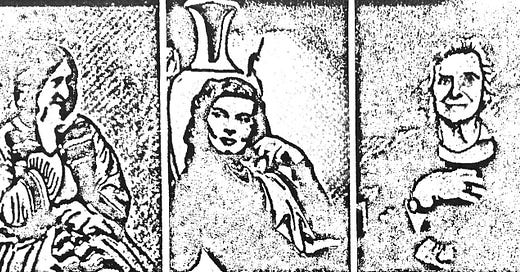This week in homeschooling sees me reading around Middlemarch: literary critic Gillian Beer on George Eliot’s response to Darwin in Darwin’s Plots (1983) and New Yorker-writer Rebecca Mead’s memoiristic study, the popular My Life in Middlemarch (2014). My dad’s birthday movie choices proved to be uncanny analogues of our reading: Mistress America (2015, dir. Noah Baumbach) and Woman of the Year (1942, dir. George Stevens).
(Okay, you might be thinking, Why has this Substack turned into a running commentary on Middlemarch? There was this post, then this one, and now whatever this is. Maybe it’s because I’m failing to avoid my fate as a teacher of English literature. At a certain level, I know studying literature is the only thing worth doing—but I’m wary of that life, too, for it can remove you from this time and place, indispose you to the world of the living by being too much with the dead.)
What do I mean when I say these movies, rather randomly chosen by my dear dad (whose movie selections are usually mercilessly shot-down), are cinematic expressions of the writings of George Eliot? Or of the reception of Eliot by contemporaries like Beer and Mead? I mean, they give expression to ‘the common yearning of womanhood’—that inchoate, baffling, ever-present force that is special to you and shared by every woman.
The question of what a substantial, meaningful life might look like for a woman preoccupies Eliot in all her works, Mead writes, and she demands that her readers engage these questions: “How on earth might one contain one’s intolerable, overpowering, private yearnings? Where is a woman to put her energies? How is she to express her longings? What can she do to exercise her potential and affect the lives of others? What, in the end, is a young woman to do with herself?” Thank you, Rebecca Mead, I am feeling rather drained by my yearnings! I look to Middlemarch for answers.
But Eliot never tells us straightforwardly how to be a successful, undrained woman, and rightly so. The book wouldn’t be worth revisiting if she did. For a writer whose works are often mistaken as moral instruction manuals she is remarkably unwilling to present anything as fully resolved or doctrinal. Even the ending of Middlemarch only seems satisfying. It is every ending and no ending, “a beginning as well as an ending,” as the first line of the Finale reads. Readers are both relieved and left floundering. The narrator reminds us that there are other Dorotheas, that this is merely the ending of “the Dorothea whose story we know.” We have an ending, but it’s not the ending, the necessary ending—it’s one of many possible endings. The question remains: Where does a woman put her energies? What is a “Woman of the Year”?
Next week I’ll write about the so-called comedy Woman of the Year, especially the spectacularly botched ending. So go watch it. I’ll write about Katharine Hepburn, more about George Eliot, what kind of teacher Gillian Beer was, how to be a professional and successful woman who is also a loved and loving woman.





